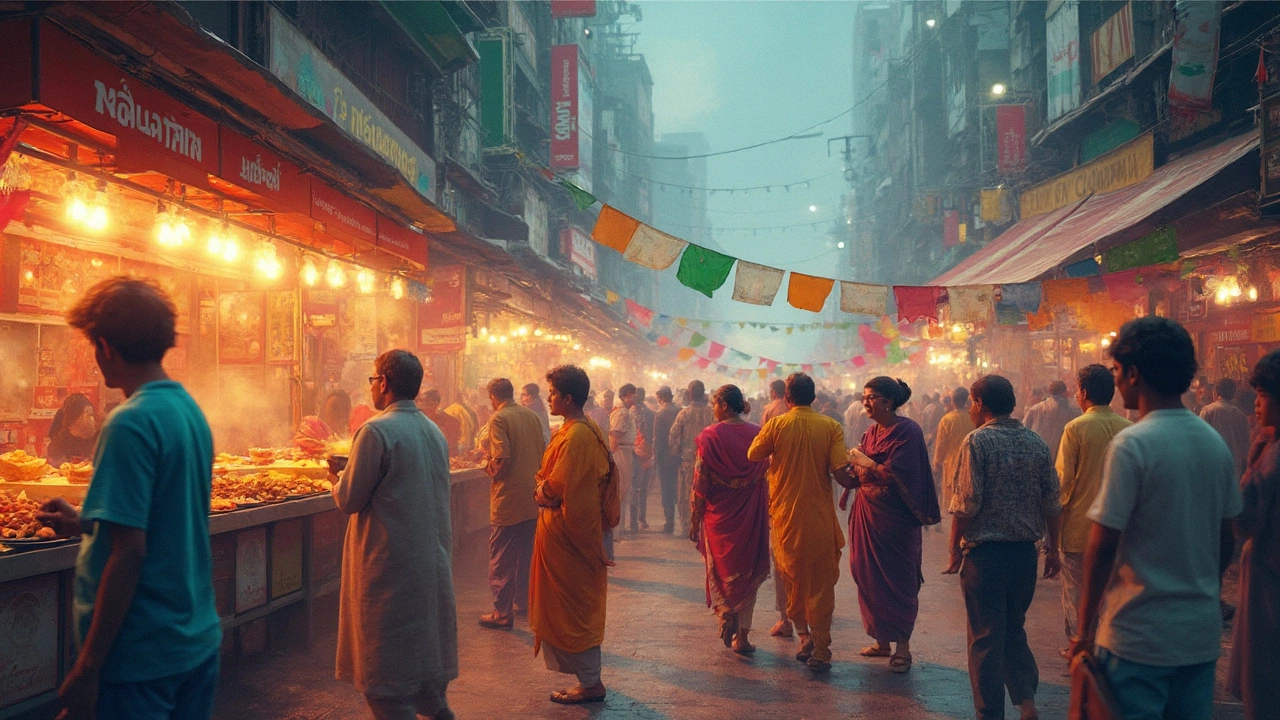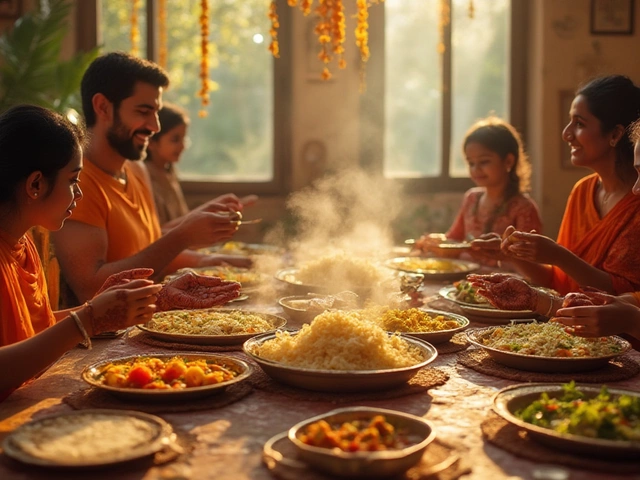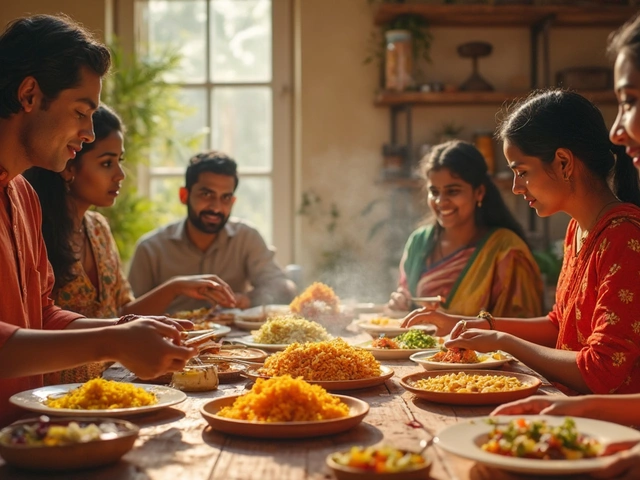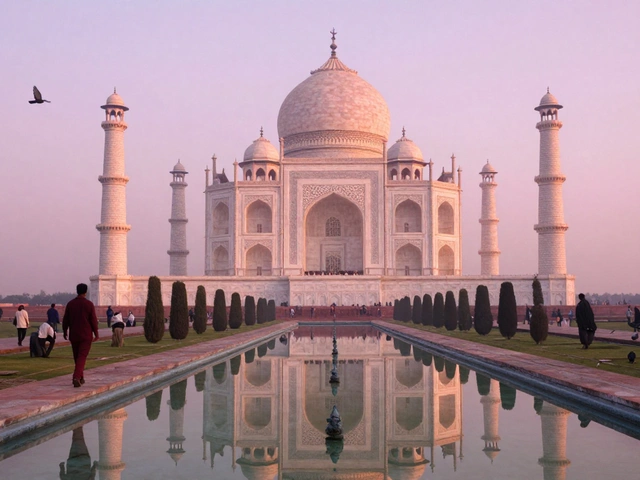Curiosity about what people really eat in India leads straight to one answer—rice. Walk into almost any Indian kitchen, from a village to a busy city apartment, and there's a good chance you'll spot steaming rice on a plate. It's not just about tradition—rice is everywhere because it's affordable, cooks fast, and works with all sorts of tastes, whether it’s spicy, mild, tangy, or even sweet.
In fact, India is one of the world’s top rice producers, and locals turn it into so much more than just plain rice. There’s biryani for feasts, curd rice in the south for soothing the stomach, and simple steamed rice with dal to keep things basic and satisfying. Even if you're new to Indian food, starting with rice dishes is the easiest way to find what you like without getting overwhelmed.
- Rice: The Grain on Every Indian Plate
- How Chapati and Roti Compete
- Dal: The Comfort Bowl
- Street Food: Popular Picks Across Cities
- Tips for Trying India’s Most Eaten Foods
Rice: The Grain on Every Indian Plate
If you ever wondered what gets dished out most often in Indian homes, it's not even close—it's rice. Just about every region, from Assam to Andhra Pradesh, makes rice their go-to. According to the Indian Ministry of Agriculture, India grows over 120 million tons of rice a year, making it the second largest producer in the world, right behind China.
The magic of rice in India isn’t just about quantity—it's about variety too. Every state seems to have its own favorite way of serving rice:
- Steamed rice: The classic. It’s the backbone for curry pairing everywhere from Kerala to Kolkata.
- Biryani: This spicy, fragrant rice dish has fans everywhere, but Hyderabad and Lucknow fight for bragging rights.
- Pulao: Think of it as biryani’s simpler, less spicy sibling—colorful and packed with veggies.
- Curd rice: Especially in the south, mixing rice with yogurt is a comfort food must-have.
- Lemon, tamarind, or coconut rice: South Indian menus are full of these zingy, flavored staples.
Why is rice in India such a staple? It’s filling, affordable, and works for both vegetarians and non-vegetarians. More importantly, rice adapts to local weather—places with heavy rains like Bengal, Assam, and Tamil Nadu grow loads of it, making rice the natural everyday choice.
Check out this quick breakdown on how different regions rely on rice:
| Region | Main Rice Dish | Popular Pairing |
|---|---|---|
| West Bengal | Steamed Rice | Fish Curry |
| Punjab | Jeera Rice | Rajma (Kidney Bean Curry) |
| Tamil Nadu | Curd Rice | Pickles & Papad |
| Kerala | Matta Rice | Coconut-based Stews |
| Hyderabad | Biryani | Salan & Raita |
Even street food jumps in on the action—rice bowls, fried rice, and idlis made from rice batter fill up hungry crowds everywhere. Trying local rice dishes is one of the easiest ways to get a taste of everyday India, no matter where your travels take you.
How Chapati and Roti Compete
When it comes to the most eaten things in India, Indian cuisine is split between rice and flatbreads like chapati and roti—especially in the north, west, and central regions. These breads aren’t just “side dishes.” For millions of Indians, they’re the real meal, made fresh twice a day, almost every day.
Chapati and roti look almost identical–both are round, soft wheat flatbreads. The real difference? Chapati is usually a bit thinner and softer, while roti can be slightly thicker and sturdier. What matters is their importance on the Indian table: they’re perfect for scooping up veggies, curries, or even plain yogurt.
Check out this rough breakdown:
| Region | Main Staple | How Often Eaten |
|---|---|---|
| North India | Chapati/Roti | Almost every meal |
| West India | Roti | Daily |
| East & South India | Rice | Almost every meal |
What makes roti and chapati such stars in Indian food staples? For one, wheat is easier to grow across northern plains, so flatbread became part of local culture. Plus, making chapatis fresh each day is almost a family ritual. Kids usually get their first kitchen lessons rolling dough and flipping chapatis on a hot pan.
If you’re traveling through India, don’t miss local twists. Try fluffy phulkas in Mumbai or super-thin tandoori rotis from Delhi. Out at roadside dhabas (highway restaurants), you’ll find hot rotis served with spicy daal or sabzi—simple, cheap, and super filling.
Tip: If you’re watching calories or want whole grains, ask for rotis made with bajra (pearl millet) or jowar (sorghum). Locals switch up their flatbread based on the season and diet, and every region has its own favorite combo.

Dal: The Comfort Bowl
Dal isn’t just another dish—it’s basically comfort food for most Indian homes. This humble bowl of cooked lentils shows up everywhere, from five-star hotels to roadside dhabas and family kitchens. For a lot of people, a simple plate of dal and rice is the easiest, healthiest, and most filling meal option.
You’ll find dozens of types of dal across India. Some common ones are toor dal (pigeon pea), moong dal (mung bean), masoor dal (red lentil), and chana dal (split chickpeas). Each one has its own taste, texture, and place in daily meals.
Here’s a quick look at the main types:
- Toor Dal: Staple in western and southern India. Yellow and a bit nutty.
- Moong Dal: Light, fast to cook, and super mild. Popular for people recovering from illness or just wanting something light.
- Masoor Dal: Reddish when raw, turns golden after cooking; great for thick, hearty curries.
- Chana Dal: Firm, slightly sweet, and filling. Often used in snacks too.
What makes dal a go-to? First, it’s packed with protein, making it super important for vegetarians. Second, it’s cheap and stores well, even in hotter parts of the country. Most households whip up dal with just a few basic spices—cumin, turmeric, chili, sometimes garlic. You can dial the spice up or down, add veggies, or even mix different lentils together. It’s really flexible based on what’s in your kitchen.
Ever wonder how much of a staple dal is? An average Indian eats around 20–25 kg of pulses per year, much of it as some kind of dal. That’s serious comfort food status.
If you want to try the most authentic bowl, grab a thali meal at a local spot—dal will always be front and center, no matter where you are in India. If you’re cooking at home, rinse your lentils well, season with a quick sauté of spices at the end (that’s called a tadka), and eat it hot. It’s as simple as it gets, and yet somehow always special.
| Popular Dal Types | Main Region | Main Use |
|---|---|---|
| Toor Dal | Maharashtra, Gujarat, Karnataka | Everyday curries |
| Moong Dal | North India | Light stews, soups |
| Masoor Dal | Pan-India | Hearty dishes, fast meals |
| Chana Dal | All regions | Curries, snacks |
Street Food: Popular Picks Across Cities
When people talk about Indian cuisine, street food always pops up. It's the real taste of local life, packed with flavors you just can't get from fancy restaurants. Every Indian city has its signature snack, and folks line up for these bites any time of the day. If you’re planning to try the most eaten food in India, you should definitely hit the streets.
Lucky for travelers, street food is usually made right in front of you, so it feels fresh and safe if you stick to the crowded stalls (locals know what’s good). Some superstar dishes:
- Pani Puri (also called golgappa or puchka) – Crispy shells filled with spicy water, potatoes, and chickpeas. It's a must in Mumbai, Delhi, and Kolkata.
- Vada Pav – A spicy potato patty in a soft bun, like Mumbai’s answer to the burger.
- Chole Bhature – Puffy fried bread with chickpea curry, found everywhere in North India, especially Delhi and Punjab.
- Dosa and Idli – South India’s answer to on-the-go eating: light, rice-based crepes or fluffy steamed cakes.
- Jalebi – Golden, sugary spirals, deep-fried and dipped in syrup. You’ll spot these all over North India’s morning markets.
Street food isn’t just delicious—it's fast on the wallet, too. You can grab a killer meal for the price of a coffee back home. If you’re worried about hygiene, here are a few tips:
- Pick stalls with a steady crowd—they turn over food fast, so it’s fresher.
- Avoid uncooked stuff like raw chutneys or salads, just to be safe for your stomach.
- Carry hand sanitizer and napkins. Things get messy fast, but it’s all part of the fun.
It’s wild to imagine, but street food sales in India hit around 300 billion rupees each year. That tells you just how big this snack obsession is. Check the table below for which city is best known for each street snack:
| City | Top Street Food |
|---|---|
| Mumbai | Vada Pav, Bhel Puri |
| Delhi | Chole Bhature, Chaat |
| Kolkata | Puchka, Kathi Roll |
| Bangalore | Dosa, Idli |
| Lucknow | Tunde Kabab |
What’s the real takeaway? If you want to experience the most eaten food in India, street food has to be on your hitlist. Just follow your nose (and the queues).

Tips for Trying India’s Most Eaten Foods
Eating your way through India calls for a game plan. Want to taste what locals eat daily? Here’s how to do it right and avoid missing out on the most eaten food in India, no matter if you're traveling from Delhi to Chennai.
- Start with local thali: A thali gives you small servings of staples like rice, chapati, dal, and sometimes regional curries, all on one plate. It’s the fastest way to sample multiple flavors in one meal without ordering everything individually.
- Stick to busy spots: The best indicator of fresh food is a crowd. If you see lots of locals lining up at a street stall or restaurant, you’re likely to get rice and dishes cooked just right.
- Try rice at both lunch and dinner: In many states, especially in the south and east, rice is served twice a day. Don’t miss it paired with sambar or curd if you want the full experience.
- Ask for the simplest combo: When in doubt, order rice with dal (lentil soup). Every region has its own spin, but it’s always tasty, filling, and easy on the stomach.
- Don’t ignore hygiene: Handwashing is standard practice. Use your right hand (not the left) to eat, especially if going traditional—which is the norm with foods like rice and roti.
- Look for variety by region: While rice is the top contender, in north and west India, you’ll also find chapati or roti on many plates. Mix it up depending on where you are and what locals eat around you.
Some useful numbers: Did you know that, as of 2024, India produces over 120 million metric tons of rice each year? Here’s how that rice habit breaks down by region:
| Region | Main Staple | Average Meals with Rice (per week) |
|---|---|---|
| South India | Rice | 12-14 |
| East India | Rice | 10-12 |
| North India | Wheat (Chapati/Roti), Rice | 3-6 |
| West India | Wheat (Chapati/Roti), Rice | 4-7 |
Travel tip: If you’re not used to Indian spices, tell your server you'd like "less spicy." And never feel shy to ask what’s actually in a dish—locals love sharing what goes into their favorite meals. The Indian food staples scene is warm, social, and way easier to enjoy if you’re curious and open. So go ahead, dive in, and don’t leave until you’ve tried a real homemade dal-chawal (rice and lentils) meal like the locals do.








